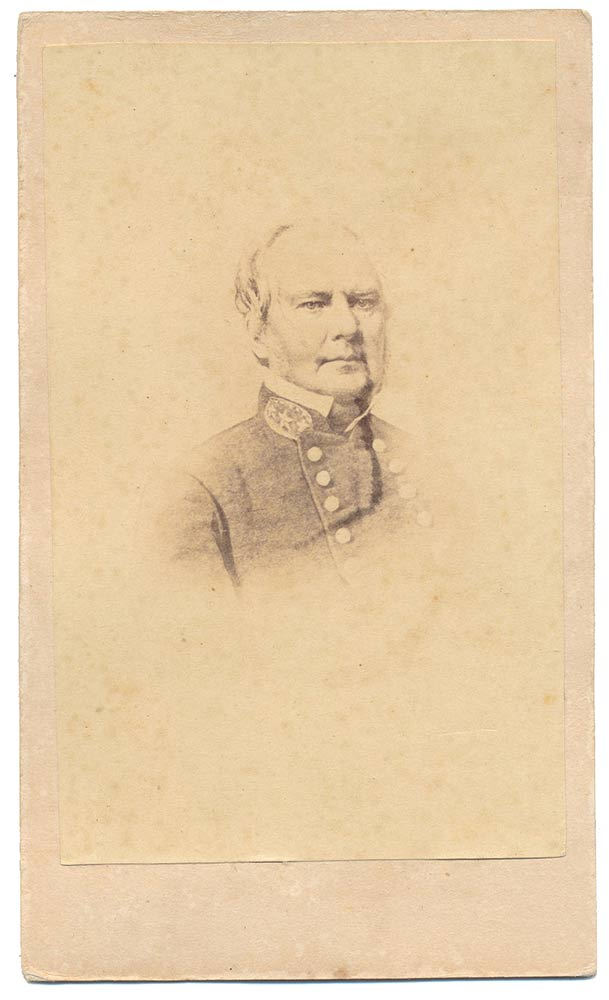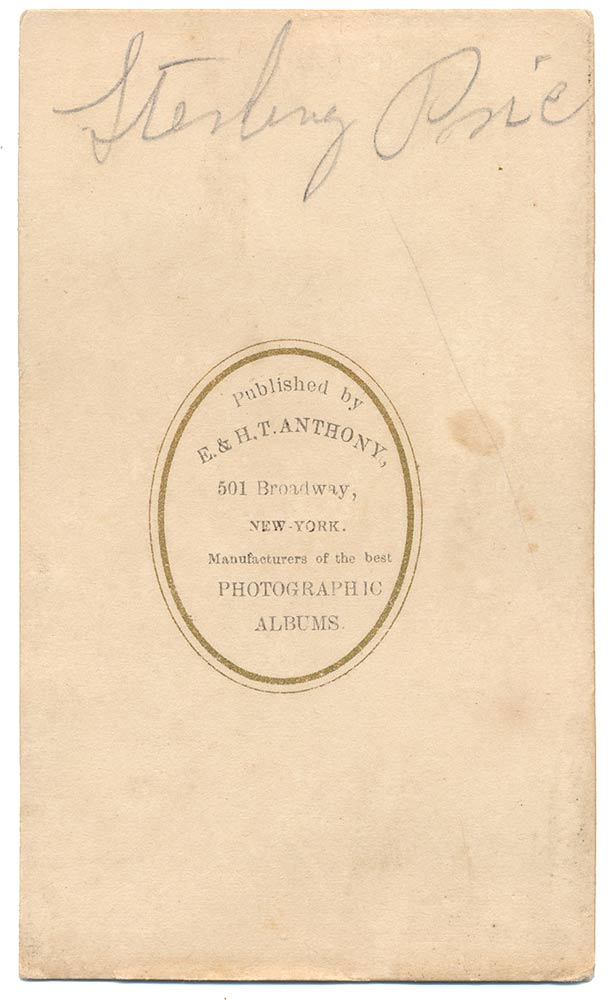site search
online catalog
CDV OF CONFEDERATE GENERAL STERLING PRICE

Hover to zoom


$135.00
Quantity Available: 1
Item Code: 855-97
Shipping: Determined by Method & Location of buyer
To Order:
Call 717-334-0347,
Fax 717-334-5016, or E-mail
Period lithograph of General Sterling Price in the uniform of a Confederate general.
Clarity is good but the contrast is just a bit light near the top of the General’s head. Mount and paper are good.
Reverse has a photographer’s imprint for E. & H. T. ANTHONY… NEW YORK. Pencil ID at top reads “STERLING PRICE.”
The American Battlefield Trust supplies the following biography.
“Major-General Sterling Price, called lovingly by his soldiers "Old Pap," was born in Prince Edward county, Va., on the 14th of September, 1809. His early education was acquired in the schools of his native county, where he was prepared for Hampden-Sidney college.
After completing the usual course in that institution, he returned to his home and became a deputy in the clerk's office. At the age of 21 he emigrated to Missouri, when the city of St. Louis was little more than a depot for the Indian trade, and when the population of the State was very scattering. He made his home in Chariton County and soon after received an appointment as brigadier-general in the State militia.
From his earliest manhood, General Price was a Democrat and in 1836 was elected as such to the general assembly of Missouri. He was again elected a representative in 1840 and 1842 and at each session was chosen speaker of the house. In 1844 he was elected to Congress and served until the opening of the war with Mexico, when he raised a regiment and had an independent command in New Mexico and Chihuahua.
He gained victories over greatly superior forces at Cancada, Lambonda and Taos. In this latter battle with 300 men, he captured 1,500 prisoners. For these services President Polk appointed him a brigadier general.
Moving next against Chihuahua, at Santa Cruz de Rosales, he captured the army of General Trias, double his own. This was really the last battle of the war; for a treaty of peace between the United States and Mexico had been signed a short time before.
At the next State election General Price was elected governor of Missouri by a majority of 15,000 votes. Upon the election of Abraham Lincoln as president, Missouri called a convention of which Price was elected president. He was at the time an ardent Union man, and at the first there was not a secessionist in that body. But when it was evident that President Lincoln intended to pursue a coercive policy, the Missouri State Guard was formed, with Sterling Price as major-general.
General Price still attempted to preserve the peace of Missouri, but when General Lyon captured Camp Jackson and shed the blood of the Missourians unnecessarily, as Price and many other of the best people of the State thought, the Missouri State Guard and their leader prepared for resistance.
The battle of Elkhorn Tavern or Pea Ridge, in North Arkansas, was really won by Price and his Missourians, but Van Dorn, discouraged by the death of McCulloch and McIntosh and the consequent confusion in the wing commanded by them, and mistakenly thinking the enemy's force greatly superior to his own, gave up the victory in his grasp and retreated.
General Van Dorn in his report says: "During the whole of this engagement I was with the Missourians under Price, and I have never seen better fighters than these Missouri troops, or more gallant leaders than Price and his officers. From the first to the last shot they continually rushed on, and never yielded an inch they had won; and when at last they received orders to fall back, they retired steadily and with cheers. General Price received a severe wound in the action, but would neither retire from the field nor cease to expose his life to danger."
After the battle of Elkhorn, Price received his commission as major-general in the Confederate army, dated the day before that battle. Shortly after the battle of Shiloh, General Price with his Missourians accompanied Van Dorn to the east of the Mississippi, and after Bragg had departed for Kentucky, they were left to face greatly superior numbers under Grant and Rosecrans.
At Iuka and Corinth, he and his men fought with great valor. The year 1863 found Price again in the Trans-Mississippi. But he was always under the orders of others, some of whom were inferior to himself in ability.
At Helena, on July 4, 1863, Price's men were the only part of the army that carried the enemy's works. He co-operated with Kirby Smith in the campaign against Banks and Steele in 1864. General Price made his last desperate effort to recover Missouri in the latter part of 1864.
His campaign was marked by brilliant achievements, but at last, when within a short distance of Kansas City, he was confronted by overwhelming numbers of the enemy and forced to retreat.
At the close of the war he was included in Kirby Smith's surrender, but preferring exile to submission he left the country and found refuge in Mexico. There he engaged in a scheme of colonization under the imperial government, but it proved a very unsatisfactory enterprise.
He returned to the United States and died at St. Louis, Mo, on the 29th of September, 1867 and is buried there in Bellefontaine Cemetery. [ad] [ph:L]
~~~~~~~~~~~~~~~~~~~~~~~~~~~~~~~~~~~
THIS ITEM, AS WITH ALL OTHER ITEMS AVAILABLE ON OUR WEB SITE,
MAY BE PURCHASED THROUGH OUR LAYAWAY PROGRAM.
CLICK HERE FOR OUR POLICIES AND TERMS.
THANK YOU!
Inquire About CDV OF CONFEDERATE GENERAL STERLING PRICE
Most Popular
Historical Firearms Stolen From The National Civil War Museum In Harrisburg, Pa »
Theft From Gravesite Of Gen. John Reynolds »
Selection Of Unframed Prints By Don Troiani »
Fine Condition Brass Infantry Bugle Insignia »
Large English Bowie Knife With Sheath 1870’S – 1880’S »
Imported (Clauberg) Us Model 1860 Light Cavalry Officer's Saber »
featured item
A FINE EXAMPLE OF A CONFEDERATE INFANTRYMAN'S KEPI
This cap's crown, top and base band are made from a medium weight open weave woolen fabric which may be a blend of sorts. It certainly looks "home spun". The kepi gives indications of being a depot made item but may actually have been homemade as… (1268-037). Learn More »


